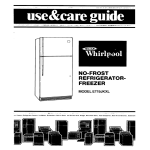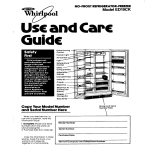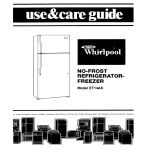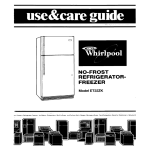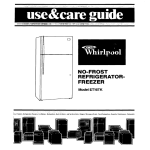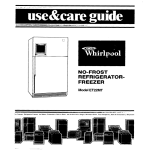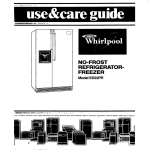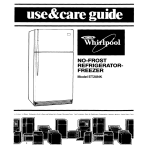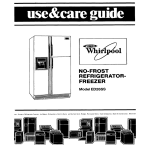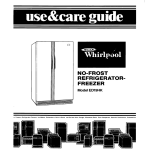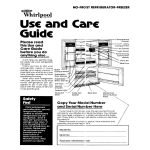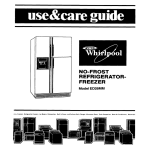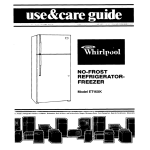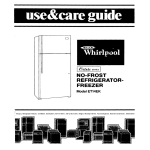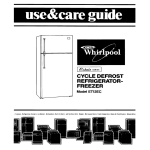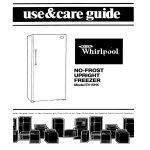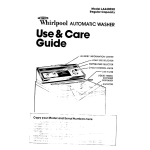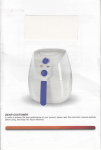Download Whirlpool ET22ZM User's Manual
Transcript
4 NO-FROST REFRIGERATORFREEZER Model ET22ZM i IS. Freezers. Refrlgeralor-Freezers. “,. ,_ j..* 1. ~,. i ,. ,2. wj .- ‘Lg? :‘*A P! ~~~~~~,~~~ Ice Makers. Chshwashets. Bwll-In Ovens. and Surlace Umls. Ranges. MIcrowave Ovens. Trash Compactors. Room Clr Condllloners. Oehumldlll ‘lome rot &erc tcrs (NO &Islgned tc CIO. Contents Page 7 7 7 8 Page SAFETYFIRST BEFOREYOU PLU&T IN Changrngthe Light Bulb Automatic Ice Maker Removing the Base Grille Sounds You May Hear Energy Saving Tips 3 Install Properly Level Refrigerator-Freezer Remove Sales Labels Clean It. Plug It In USING YOUR REFRlGERAibR Setting thecontrols Changing the Control Settings Power Saving Control Adjusting the Refrigerator Shelves Moving the Meat Pan Removing the Crispers and Covers Adjusting the Door Brns Removing the Freezer Shelf 3 4 4 4 4 4 5 5 i, ; 6 6 6 6 6 c 1986 Whirlpool Before using your refrrgerator, you are personally responsible for making sure that it l IS Installed and leveled on a floor that WIII hold the weight, and In an area suitable for Iis srze and use l ISconnected only to the right kind of outlet, with the right electrical supply and grounding [Refer to your “ElectrIcal Requirements and Groundrng Instructions”) l IS used only for lobs expected of home re frigerators CLEANING YOUR REFRIGiiAki Cleaning :: Chart, FOOD STORAGE GUIDE :: ::: Storrng Fresh Food Freezing and Storing Frozen Foods VACATION AND MOVING CARE IF YOU NEEDSERVICE OR ASSISTANCE 1 2 3 4 BeforeCallingfor Assistance If You Need Assrstance If You Need Service If You Have a Problem 8 8 9 10 10 11 14 15 15 15 15 15 Corporation l l l l l l IS not near an oven, radiator or other heat source. IS properly maIntained IS out of the weather. IS used in an area where the room temperature will not fall below 55 F (13” C) ISnot used by those who may not understand how it should be used IS not loaded with food before it has time to get properly cold Install properly.. . Remove sales labels.. . Remove the Consumer Buy Guide label, tape and any inside labels before using the refrigerator To remove any remaining glue: 1 Rub briskly with thumb to make a ball then remove OR 2 Soak area with dishwashing detergent solution (1 teaspoon detergent in 1 quart warm water] before removing glue as described In step 1 DO NOT USE rubbing alcohol or flammable or toxic solvents, such as acetone, gasoline, carbon tetrachloride, etc. These can damage the material. NOTE: DO NOT REMOVE ANY PERMANENT INSTRUCTION LABELS INSIDE YOUR REFRIGERATOR. Do not remove the Tech Sheet fastened under the refrigerator at the front. Clean it.. . 1 Allow % Inch (1.25 cm] space on each side and at the top of the refrigerator for ease of installation 2. If the refrigerator IS to be against a wall, you might want to leave extra space so the door can be opened wider. 3 The refrigerator back can be flush against the wall Level refrigerator-freezer.. Levetling SK4 . 1 Clean your refrigerator before using It See cleaning instructions on page 9 Plug it in... 3-prong grounding type wall receptacle Front Roller grounding plug Refrigerator Power Cord Right to Raise, Left to Lower I. 2. 3. 4. Remove base grille (see page 7 ). To raise front, turn each screw to the right To lower front, turn each screw to the left. Check with level. RECOMMENDED GROUNDING METHOD A 115 Volt. 60 Hz, AC only 15 or 20 ampere fused and properly grounded electrlcal supply is required It IS recommended that a separate circuit serving only this appliance be provided. Do not use an extension cord. Use a receptacle which cannot be turned off with a switch or pull chain. See lndlvldual electrical requirements and grounding ature package instruction sheet in your liter- . Setting the controls.. Glve the refrigerator pletely betore addlng . Controls for the refrigerator and freezer are rj the refrigerator When the refrigerator IS plugged in for the first time 1 Set the TEMPERA TURE CONTROL tc 3 Changing 2 Set the AIR C2N TROL to B the control settings.. cal’ your o If Refrlgeratol Owe 15) TOO COLD If ICE Isn’t MADE FAST ENOUGH The controls WIII be set about right when milk or IuIce IS as cold as you like and when ice cream 1sfirm Do not block the air outlet on the control panel. alockIng It can slow the air movement needed to Keep temperatures at the level you set. l l l Adjust the Temperature Control first Walt at least 24 hours between adlustments Then adjust the Air Control, If needed Heavy Ice usage Very cold room iemperature [can’t cycle often enough) Door opened often ,arge amant of food added Very warm or very cold room temperatures If BOTH SECTIONS are TOO WARM Power Saving Control.. These settings should be about right for normal household refrigerator usage. REASONS: Door opened often Large amount of food added Room temperature too warm Door opened often Large amount of food added Very cold room temperature (can’t cycle often enough) Controls not set correctly for vour condittons QUESTIONS? assistance telephone number eral hours.) . If you need to adjust temperatures In the refrlgerator or freezer, use the settings Ilsted In the chart below CONDITION : If Refrigerator Section IS TOO WARM If Freezer Sectlon IS TOO WARM time to cool down comfood. (This may take sev- RECOMMENDED SETTINGS: Temperature Air Control Control 4 C Temperature Air Control Control 4 A Temperature Air Control Control 2 B Temperature Air Control Control 3 A Temperature Air Control Control 4 . The Power Saving Control on the Control Cor sole operates electric heater around the door operings. These heaters help keep moisture from forming on the outside of the refrigerator ’ ’ Use the “OFF sett ng when humidity IS ‘ON 2 Use the “0N”setting if moisture fotms on the outside of the refrigerator. B Adjusting the refrigerator shelves... Shelves can be adjusted to match the way you use your refrigerator Glass shelves are strong enough to hold bottles, milk and other heavy food (terns To remove glass shelves: 1 Tilt up at front. 2 Lift up at back. 3 Pull shelf straight out To replace: I. Gurde the rear hooks into the slots In the shelf supports 2 Tilt up front of shelf until hooks drop into slot Lower front of shelf to level positron G/cm shelves ore heavy Be careful Moving the meat pan.. . The meat pan can be taken out and moved the same way as the shelves. Remove the meat pan first I Removing: 1 2 3 4 5 6 Slrde the meat pan out to stop Lrft the front of meat pan Slrde pan the rest of the way out Tilt cover up at front Lrft up at back. Pull strarght out Replaclng: 1 Guide the rear hooks Into the slots In the shelf supports. 2 Tilt up front of cover untrl rear hooks drop Into slots. Lower front of cover to level positron 3 Replace meat pan In reverse order. Removing the crispers and crisper covers... Removing crispers: ? 2 3 4 Skde cnspers stratght out to stop Lift the front Slrde the rest of the way out Replace in reverse order Removing the Cover. covers: Covers are held In by two pegs at the back and t’*L notched tabs in front 1 Press front out of wav 2 Lift cover front 3 Loft back out of pegs 4 Replace In reverse order Adjusting the door bins... The 4 door bins are adystable needs to meet your Storage To remove door bins: I. Lift front of bin slightly. 2 Slide bin out of support slot 3. Replace in reverse order Removing the freezer shelf... ’ Loftfront slightly 2 Loft back off supports .3 Replace In reverse order litt the Front Then the Back t ~?ecessar~~.the center leg can be made shorter or orjger to help level the crisper covers Turn the leg clxkwnlse to make I+ longerTurn the leg counterclockw se ts shorten it support slot Changing the light bulb... WARNING: Before removing the light shield for cleaning or for replacing the bulb, either unplug refrigerator or disconnect electricity leading to refrigerator at the main power supply. Shock and injury can occur if electricity remains connected. Push lightly on the top center of the light shield until the notched iab unhooks from the control panel Pull down on the shield until the tab clears the control panel LIH the back hooks oui of their slots Replace with a 40-watt appliance bulb Replace light shteld in reverse order Push in the Center; Pull Down. Automatic ice maket.. The automatic Ice maker ISin the freezer section of your refrigerator. The following things should be known for proper Ice maker use l The ON OFF lever ISa wire signal arrr Down for making ice automat~cal’i Up to shut off the ice maker l Shake the bin occasionally to keep &oes sey;c rated, and to obtain Increased storage capac~+r l l l On l l l Lower Signal Arm to Start It \ Raise Signal Arm to Stop Ice Maker l It IS normal l corner They will break apart easllv You will hear water ruqnlng w?en ice maker i working You’ll hear Ice fall into: ti‘e tl ‘I ?\I~I t -.I for Ice c’escents tc be attached Lr -J these sounds bother you The ice maker will not operate until the freezer IS cold enough to make ice This can take overnight Because of new plumbing connectIons, the first Ice may be &colored or off-flavored Discard the first few batches of Ice If Ice IS not being made fasi enough and more ice IS needed, turn the Temperature Control toward a higher number. Wait a day and, If necessary, turn the Air Control toward A If you remove the Ice bin, raise the signal arm to snu+ off the ice maker When you return the bin. push It all the way in and lower ihe arm to the ON position If cubes are stored too long, they may develop an off-flavor like stale water Throw them away They WIII oe replaced Cubes In the Ice bin can also become smaller by evaporation Good water quality ISimportant for good Ice quality I+IS not recommended that the Ice maker be connected to a softened water supply. Water softener chemicals such as salt from a malfunct~onlng softener can damage the Ice maker mold and lead to poor quality ice If a softened water supply cannot be avoided, then It IS important that the water softener be well maIntaIned and operating properly Removing the base grille... Support To replace: L Pull grille outwards as shown 3 Do not remove Tech sheet fas’ened ? Liqe up grille support tabs with metal clips ? Push, firmly to snap tnto place behlno gril c? 3 Close the doors labs Sounds you may hear... ‘/ P 3 ’ xc Possible Sounds: l l l l l Your new refrrgerator may make sounds that your old one didn’t Because the sounds are new to you. you might be concerned about them. Don’t be Most of the new sounds are normal. Hard surfaces like the floor, walls and cabrnets can make the sounds seem louder The followrng chart describes the kinds of sounds that might be new to you, and what may be makrng them Probable Causes: Slight Hum, Soft Hiss: You may hear the refrrgerator’s Clicking Sounds: The defrost trmer makes a definite click when the refrigerator also makes a sound when the refrigerator starts. or Snapping Water Sounds: fan motor and moving air stops running. It When the refrigerator stops running, you may hear gurgling in the tubing for a few minutes after it stops You may also hear defrost water running Into the defrost water pan Ice Maker Sounds: -trickling water -thud (clatter of ice) If your refrrgerator has on Ice maker, you may hear buzzing [from the water valve), trrcklrng water and the clatter of Ice dumped Into the brn Running Your refrigerator has a high-efficiency compressor and motor It will run longer than older designs. It may even seem to run most of the time. Sounds: Energy saving tips... You can help your refrrgerator use less electricit\ Check door gaskets for a tight seal Level the cab1 net to be sure of a good seal l Clean the condenser coil regularly l Open the door as few times as possrble :hsnk abocit what you need before you open the door Get everything out at one trme Keep foods organized so you won’t have to search for what you war’t Close door as soon as food IS removed l GO ahead and fill up the refrigerator, but don t ‘over crowd it so air movement IS blocked l l Cleaning your refrigerator Both the refrigerator and freezer sections defrost automatically. But both should be cleaned about once a month to help prevent odors from bulldrng up Of course, spills should be wiped up right away To clean your refrigerator, turn the Temperature Control to OFF, unplug it, take out all removable parts, and clean it according to the followrng drrectrons l l It IS a waste of electricrty to set the refrigerator and freezer to temperatures colder than they need to be If ice cream IS firm In the freezer and drunks are as cold as your family lakes them, that’s cold enough. Keep the Power Savrng Control on OFF unless morsture forms on the refrigerator exterror Make sure your refrigerator IS not next to a heat source such as a range, water heater, furnace, radrator or in direct sunlight Cleaning chart... Part What to use How to clean Removable parts [shelves, crispers, meal pan, etc.) Sponge or cloth; mild detergent and warm water l Outside Sponge, cloth or paper towel; mild detergent: appliance wax [or good auto paste wax). Wash removable parts with warm water and a mild detergent. Rinse and dry l Wash with warm water and a mild detergent. Do not use abraslve or harsh l cleansers. Rinse and dry Wax painted metal surfaces at least twice a year with appliance wax or a good auto paste wax. Apply wax with a clean, soft cloth. Do not use wax on plastic parts. l l Inside walls [Freezer should be allowed to warm up so cloth won’t stick,) Sponge, soft cloth or paper towel, baking soda, warm water, mild detergent. Wash with warm water and - mild detergent or - baking soda (2 tablespoons quart [.95 I] warm water. Rinse and dry l l Door liners and gaskets Sponge, soft cloth or paper towel; mild detergent. warm water. Wash with mild detergent Rinse and dry l l DO NOT USE cleaning waxes, cleansers containing petroleum Dark plastics [covers, panels and door bins] Mild detergent and warm water; soft, clean sponge and soft, clean cloth. [26 g] to 1 and warm water. concentrated detergents, on plastic parts. bleaches Or l Wash with a soft, grit-free cloth or sponge. . Rinse and dry with a damp, grit-free cloth or chamois, DO NOT USEpaper towels, window sprays, scouring cleansers, or flammable or toxic solvents like acetone, gasoline, carbon tetrachlorlde, etc.These can scratch or damage the material. Sponge or cloth; mild detergent and warm water Defrost pan Condenser coils Vacuum cleaner, using the extended narrow attachment . Remove base grille. (See page 7.) . To remove defrost pan, lift pan over wire brace [remove tape; if any). . Wash defrost pan with warm water and mild detergent l Rrnse and dry l Replace with notched corner to the rear l Push it all the way in l Make sure defrost drain tube is pointing Into pan. l Replace base grille. l l l Floor under refrigerator Usual floor cleaners l l l l Remove base grille. Clean dust and lint from condenser every other month. Replace base grille. at least Roll refrigerator out only as far as water supply line allows Wash floor Roll refrigerator back into place. Check to see if the refrigerator is level. Food storage guide STORING FRESH FOOD There IS a right way to package and store refrlgerated or frozen foods. To keep foods fresher, longer, take the time to study these recommended steps Leafy Vegetables Remove store wrapplng ana off bruised and &colored areas Wash IP and drain Place in plastic bag or plostlc and store in crisper Cold, moist air helps vegetables fresh and crisp Vegetables with Sk,ins (carrots, peppers) Store In crisper. plostlc bogs or plastic coctolner Fruits Wash, let dry and store in refrigerator ? plastic bogs or crisper Do not wosn or hull Derrles until they ore ready to use Sort and keep berries IP their store container In a cnsper. or store I? o loosely closed poper bag on a refrigerator shelf trim or tear cold water container keep leafy Meat* Meat ISperishable and expensive you won’t wont to waste on ounce of it through careless handling The following list and chart give you pockaging hints and time limits Store meat in the meat pan Fresh, Prepackaged Meat. Store fresh meat IP the store wrapping Vacuum packaged meat can be frozen for as long as one month if the seal IS not broken If you wont to keep It frozen longer, you should wrap It with special freezer wropplng moterIO Fresh Meat, Not Prepackaged. Remove the market wropplng paper and re-wrap in olumlnum foil for storing it unfrozen Cooked Meat. Wrap or cover cooked meat with plastic wrap or aluminum foil. Store immediately 0 Cured or Smoked Meat and Cold Cuts. Horn, bacon, sausage, cold cuts, etc keep best in origlnal wrappings Once opened, tightly re-wrap in plastic wrap or aluminum foil Canned Ham. Store In refrlgerotor unless the lobel soys It’s okay to store on the shelf Do not freeze Fresh Poultry Wrap in plastic wrap The plosilc wrap on poultry, as purchased, may be used for storage STORAGECHART FORFRESHANOCUREOMEAT* Approxlmate lime Ww Ways1 Variety Meats . . . . . . . . . . . . . . . . . . . . 1 to2 Chicken . . . . . . . . . . . . . . . . . . . . . . . . . . 1 to2 Ground Beef . . . , . . . . . . . . . . . . . . . . . . 1 to 2 Steaks and Roasts . . . . . . . . . . . . . . . . 3 to 5 Cured Meats . . . . . . . . . . . . . . . . . . . . . 7 to 10 Bacon . . . . . . . . . . . . . . . . . . . . . . . . . . . . St07 Cold Cuts . . . . . . . . . . . . . . . . . . . . . . . . 3 to B *If meat is to be stored longer than the times given. follow the directions for freezing. NOTE: Fresh fish and shellfish should be used the some day as purchased Eggs Store wlthout washing in the orIginal carton or use the Utility Bin that came with your refrigerator Milk Wipe mi’k cartons For best storage. place mll;c on Interior snelf Beverages ..Wlpe bottles and cons. Store in a door bin or inside the refrigerator Butter.. Keep opened butter in o covered dish or in the Butter Comportment When storing on extra supply, wrap In freezer packaging and freeze. Cheese. Store in the original wrapping until you are ready to use. Once opened, re-wrap tightly in plastic wrap or aluminum fotl. Condiments -Store small jars and bottles (catsup, mustard, jelly, olives] in a door bin where they are In easy reach Leftovers.. Cover leftovers with plastic wrap or oluminum foil to keep food from drying out and tronsferring food odors Plosttc containers with tight lids ore fine, too FREEZING & STORING FROZEN FOODS The freezer sectlon ISdeslgned for storage of commerclclly frozen foods and for freezing foods at home Packaging ~ The secret of successful freezlng IS In the packaging The wrap you use must be air, moisture and vapor proof The way you close and seal the package must not allow air, moisture orvapor in or out Packaqlnq done In any other way could cause food odor-anb taste transfer throughout the refrigerator and drying of frozen food Rigid polyethylene (plastic) containers with tightfitting lids. straight-sided canning freezing jars. heavy-duty aluminum foil, plastlc-coated paper and non-permeable plastic wraps (such as Saran) are recommended Note, Heat-sealed boiling bags are easy to use and can be used by themselves or as carton liners. Sealing- When sealing foods in bags squeeze out the air (liquids need headspace to allow for expansion ) Twist the top and turn It back Fasten tie securely around the doubled-over tail Put the label InsIde transparent bags, use self-adhesive label on outslde of opaque ones Air-tight wrapping calls for “drugstore” wrap Cut the sheet about one-third longer than the distance around the fo&. Bring the ends together and fold in [toward the focd) at least twice to seal out air Crease ends close to food, press air from package Fold tips over twice Finish package and tape closed NOTE With unboned meats, pad sharp edges with eXtr( wrap or use stockinette to protect the wrap fror punctures DO NOT USE: Bread wrappers l Non-polyethylene plastic containers l Containers without tight lids 0 Waxed paper l Waxed-coated freezer wrap l Thin, semi-permeable wrap None of these are totally moisture. air or vapor proof. The use of these wrapplngs could l cause food odor and taste transfer and drying of frozen food. Freezing Fruits-Select ripe, blemish-free fruii Be sure they taste as good as they look Wash 2 i 3 quarts (liters) at a time and drawn Fruit that stanc In water may lose food value and become, sogc Sort, peel, trim pit and slice as needed. Pack In rigid wide-mouthed containers or othl recommended material Leave head space to c low liquids to expand during freezing Freezing Vegetables - Freeze only fresh highquality vegetables picked when barely mature For best results, freeze no more than 2 to 3 hours after prckrng Wash in cold water, sort and c.J intc appropriate srzes Blanch or scald Pock in recomb mended contarner and freeze Do not freeze lettuce, celery, carrot strcks. potatoes or fresh tomatoes All WI/I become IImp or mushy Tomatoes WI// collapse when thawed Freezing Cooked Food - Prepare cooked foods as you would for the table, shorten cooking trmel0 to15 minutes toallow for additronal cooking durrng reheating Omit seasonrngs and part of the Irqurd. Plan to add them at reheating time. Potatoes should also be added to soup and stew at heating trme. Add crumb and cheese toppings at heatrng trme. Cool as raprdly as possible and freeze at once. Liquid or semr-lrquid dishes may be frozen In retommended containers with head-space Cosserales and other more solid foods may be frozen in the baking container If you don’t wont to leave your casserole dash in the freezer, line It with foil Bake, cool, freeze, lift out the forI package, bag it and return to freezer Freezing Meats -The meat you thaw can orl, be as good as the meat you freeze “Drugstore wrap in meal-size packages. Flat cuts or IpattIes should be wrapped rndrvidually or rn layers sepo rated by a double thickness of freezer wrap Make sure store wrapprngs are morsture and va por proof If not, re-wrap meats with one of the wraps recommended under “PackagIng Freezing Baked Goods-Wrap baked breads in recommended material Thaw In wrapping Unbaked yeast breads can be frozen after the first rrsing Punch down. wrap and freeze Bake cookies as usual Cool and freeze on trays, then pack In recommended freezer bags or cartons Unbaked cookres may be dropped, molded or rolled and frozen on cookre trays. Store in bag or carton, bake without thawing Refrrgerator-type cookies can be wrapped and frozen In roll form. Thaw only enough to slice when ready to bake. Fruit pres are best frozen unbaked. Bake without thawrng. Bake pecan and srmrlor pies before freezing .rrch fillrngs do not freeze solid Cut steam vents in top crusts when ready to bake IMPORTANT: Do not expect your freezer to quick-freeze any large quantity of food. Put no more unfrozen food into the freezer than will freeze within 24 hours. [No more than 2 to 3 pounds of fresh meat or 3 to 4 pounds of vegetables per cubfc foot of freezer space.) leave enough space for air to circulate around packages. Be careful to leave enough room at the front so the door can close tightly. Food Storage tlme MAIN DISHES Stews; meat, poultry and fish casserole . . . . 2 to 3 months TV dinners . . . . . . . . . . . . . . . 3 to 6 months DAIRY PRODUCTS Butter . . . . . . . . . . . . . . . . . . . 6 to 9 months Margarine . . . . . . . . . . . . . . 2 to 9 months Cheese: Camembert, brick, Mozzarella, farmer’s . . . . 3 months Creamed cottage . . DO NOT FREEZE Cheddar, Edam. Gouda, Swiss.etc.. . . . . . . . . . . . 6 to8 weeks Freezing can change texture of cheese. Ice cream, ice milk sherbet . . . . . . . . . . . . . . . . . . . . 4 weeks EGGS Whole (mixed) . . . . . . . . . 9 to 12 months Whttes . . . . . . . . . . . . . . . . . 9 to 12 months Yolks . . . . . . . . . . . . . . . . . . . 9 to12 months FOODSTORAGE CHART Storage times* will vary according to the quality of the food, the type of packaging or wrap used [moisture and vapor-proof), and the storage temperature which should be 0” F (-17.8”c). Storage time Food FRUITS Fruit juice concentrate . . . . . 12 months Commercially frozen fruit . . 12 months Citrus fruit and juices. . . . 4 to 6 months Others . . . . . . . . . . . . . . . . . 8 to 12 months VEGETABLES Commercially frozen . . . . . . . 8 months Home frozen . . . . . . . . . . 8 to 12 months MEAT Bacon . . . . . . . . . . . . . . . . 4 weeks or less Cornedbeef . . . . . . . . . . . . . . . . . 2weeks Cured ham . . . . . . . . . . . . . 1 to 2 months (Salting meat shortens freezer life) Frankfurters . . . . . . . . . . . . . . . . . 1 month Ground beef, lamb, veal 2 to 3 months Roasts: Beef . . . . . . . . . . . . . . . . . 6 to 12 months lamb and veal . . . . . . . 6 to 9 months Pork . . . . . . . . . . . . . . . . . . . 4 to 8 months Sausage, fresh . . . . . . . . . 1 to 2 months Steaks and chops: Beef . . . . . . . . . . . . . . . . . 8 to 12 months lamb, veal, pork . . . . . . 3 to4 months FISH Cod, flounder, haddock Sole.. . . . . . . . . . . . . . . . . . . . 6 months Blue fish, salmon . . . . . . . . 2 to 3 months Mackerel, perch . . . . . . . . 2 to 3 months Breaded ffsh (purchased] . . . 3 months Clams, oysters, cooked fish, crab, scallops . . . . 3 to 4 months Alaskan king crab . . . . . . . . . 10 months Shrimp, uncooked . . . . . . . . . 12 months POULTRY Whole chicken or turkey.. . . 12 months Duck . . . . . . . . . . . . . . . . . . . . . . . . 6 months Giblets . . . . . . . . . . . . . . . . . . 2 to 3 months Cooked poultry w/gravy . . . 6 months Slices (no gravy) . . . . . . . . . . . . . 1 month (Add sugar or salt to yolks or whole mixed eggs) BAKED GOODS Yeast breads and rolls . . . . . . 3 months Baked Brown ‘N Serve rolls . . . . . . . . . . . . . . . . . . . . . . . 3months Unbaked breads.. . . . . . . . . . . . 1 month Quick breads . . . . . . . . . . . 2 to 3 months Cakes, unfrosted . . . . . . . . 2 to4 months Cakes, frosted . . . . . . . . . 8 to 12 months Fruit cakes . . . . . . . . . . . . . . . . . 12 months Cookie dough . . . . . . . . . . . . . . 3 months Baked cookies . . . . . . . . . 8 to12 months Baked pies . . . . . . . . . . . . . . 1 to 2 months Pie dough only . . . . . . . . . . 4 to 6 months ‘Based cm U.S.D.A. and Machlgon suggesled slotage times. If electricity Cooperdwe Extension Sewce d L goes off Call the power company Ask how long power WI/I be off 1. If service IS to be Interrupted 24 hours or less, keep both doors closed This will help frozen foods to stay frozen. 2. If servrce IS to be Interrupted longer than 24 hours [o] Remove all frozen food and store in a frozen food locker Or [b) Place 2 Ibs (0.9 kg] of dry Ice in freezer for every cu. ft of freezer space. This WIII keep frozen foods for 2 to 4 days. Wear gloves to protect your hands from dry Ice burns (c) If neither food locker storage nor dry ice IS avarlable. use or can perishable food at once 3. A full freezer will stay cold longer than a partly filled one A freezer full of meat will stay cold longer than Q freezer full of baked goods. If food contains ice crystals, it may be safely refrozen, although the quality and flavor may be affected. Use refrozen foods qurckly. If the condition of the food is poor or you hove any suspicions, it is wise to drspose of it. Vacation Short vacations. Moving... .. No need to shut-off the refrigerator if you WIII be away for only a few weeks. Use up the perishables, freeze other items. Turn off your Ice maker; shut off the water supply; empty the ice brn and make sure all ice cubes are dispensed out of the mechanrsm Long vacations. .. Remove all the food if you are going for a month a more At least a day ahead. turn off the water supply to the ice maker. When the last load of Ice drops, turn off the ice maker Unplug the refrigerator and clean It rrnse well and dry. Tape rubber or wocd blocks to both doors keeping them open far enough for arr to get in ‘hrs WIII keep odor and mold from building up WARNING: Tape blocks out reach...do not allow the retrigemtor when blocked open. They injured or trapped. To restart refrigerator, 14 ot a child’s children near the doors are may become see ‘Using Your Refrigerator Shut off the ice maker water supply a day ahead of time Disconnect the water lrne After the last supply of ice drops, I~ftthe signal arm to turn off the Ice maker. Remove all food Pack frozen foods In dry ice. Un plug the refrigerator and clean tt thoroughly. Remove everythrng that comes out. Wrap all parts well and tape them together so they don’t shift and rattle Screw in the levelling rollers, tape the doors shut, tape the electric cord to the cabinet. When you get to your new home, put everything back. and refer to page 4 Don’t forget to reconnect the water supply line if you have an icemaker. QUESTIONS? .call your COOL-LINE” service assistance telephone number Iww 151. If you need service or assistance, we suggest you follow these four steps: 1. Before calling for assistance... Performance problems often result from lrttle things you con find and fix yourself without tools of any kind If your refrtgemtor will not operate: Is the power supply cord plugged Into a live crrcurt with the proper voltage? (See page 4.) Hove you checked your home’s morn fuses or circuit breaker box? Is the Temperature Control turned ON7 l l l If there is a mttling or jingling noise, or other unfamiliar sounds: Is something on top or behind the refrigerator making noise when the refrigerator is running? New features on your new refrigerator make new sounds. You may be hearrng air flowrng from the fans, timer clicks for the defrosting cycle, defrost water drarning into the defrost pan l l If your ice maker will not opemte: Has the freezer hod enough time to get cold? With a new refrigerator, this might take overnight Is the srgnal arm ON in the down posrtron7 Is the water valve turned on? Is water getting to the ice maker? l l l If there is water in the defrost pan: In hot, muggy weather, this IS normal. The pan con even be half full Make sure the refrigerator is level so the pan doesn’t overflow. l If the light does not work: l l Hove you checked your home’s morn fuses or circuit breaker box? Is the power supply cord plugged Into a love circuit wrth the proper voltage? (See page 4 ) If a bulb is burned out: l See rnstructrons for changing Use appliance bulbs only light bulbs on page Call Whlrlpool COOL-LINE@servlce assfstance telephone number. Dial free from: Continental U.S. . . . . . . . . . . . . . (800) 253-1301 Michigan . . . . . . . . . . . . . . . . . . . . (800) 632-2243 Alaska 6 Hawaii . . . . . . . . . . . . (800) 253-1121 and talk with one of our trained sultant con instruct you in how operation from your appliance sary, recommend a qualified your area. 3. Consultants. The Conto obtain satisfactory or, if service is necesservice company in If you need service*... Whirlpool has a notionwide network of franchised TECH-CARE@ Service Companies. TECH-CARE service technicians ore trained to fulfrl the product warranty and provide after-warranty servrce. FRANCHISED SERVICE I anywhere In the United States. To locate TECHCARE serwce in your area, call our COOL-LINE service assrstance telephone number (see Step 2) or look in your telephone drrectory Yellow Pages under. 7GCARE APPLIANCES-HOUSEHOLDMAJOR -SERVICE A REPAIR WHIRLPOOL APPLIANCES FRANCHISEDTECH-CARE SERVICE SERVICE XYZ SERVICECO 123 MAPLE ELECTRlCAL APPLIANCESMAJOR-REPAIRING L PARTS ORWHIRLPOOL APPLIANCES FRANCHISE0 TECH-CARE SERVICE COMPANIES 999-9999 SERVICE XYZ SERVICECO 123 MAPLE OR U,MPANIES 999-9999 WASHING MACHINES, DRYERS (L IRONERS-SERVICING WHIRLPOOL APPLIANCES FRANCHISED TECH~CARESERVICE SERVICE XYZ SERVICECO 123 MAPLE COMPA.~lES 999-9939 7 If the motor seems to run too much: Is the condenser, behind the base grille, free of dust and lint? l On hot days. or if the room IS worm, the motor natu rally runs longer l If the door has been opened o lot, or If a large amount of food has been put In, the motor WIII run longer to cool down the Interior Remember: Motor running time depends on different things: number of door openings, amount of food stored, temperature of the room, setting of the controls And, your new refrigerator may be larger than your old one so it has more space to be cooled. It also has a regular freezer instead of a frozen food compartment. All this means better refrigeration and may require more running time than your old one l 2. If you need assistance*... 4. If you have a problem*... Call our COOL-LINE sewice assistance telephone number [see Step 2) and talk with one of our Consultants. or if you prefer, write to Mr Robert Stanley Division Vice President Whirlpool Corporatton 2000 US-33, North Benton Harbor, Ml 49022 *If you must call or write. please provide- model number, serial number, dote of purchase, and a complete description of the problem. This information is needed in order to better respond to your request for assistance. FSP 1s a regIstered trademark of WhIrlpool Corporatlon for quality parts Look for this symbol 01 qualIly whenever you need a replacement parf for your WhIrlpool appliance FSP replacement patis WIII flt rIghI and work rlghl because they are made to the same enactlng speclllcations used lo build every new WhIrlpool appliance Whirlpa Home A Appliances Makmg your world a little easier. Part No. 1110163 01986 Whirlpool Corporation Printed in U.S.A. I e Makers : .2-l, ‘i Dishwashers. Built-In Ovens. and Surlace Units. Ranges. Mlcroware Ovens. Trash Compactors, Room Au Condllloners. Oehumldllwrs. Automatic Washers. Clothes OI$.
















